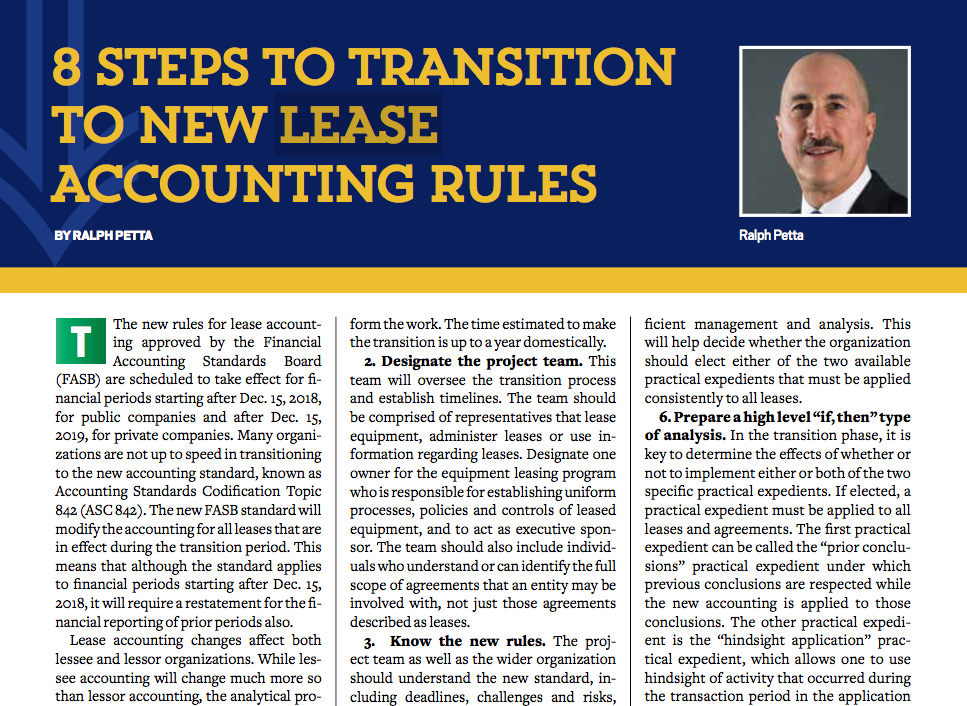8 Steps to Transition to New Lease Accounting Rules
BY Ralph Petta

The new lease accounting rules approved by the Financial Accounting Standards Board (FASB) are scheduled to take effect for financial periods starting after Dec. 15, 2018, for public companies and after Dec. 15, 2019, for private companies. Many organizations are not up to speed in transitioning to the new accounting standard, known as Accounting Standards Codification Topic 842 (ASC 842). The new FASB standard will modify the accounting for all leases that are in effect during the transition period. This means that although the standard applies to financial periods starting after Dec. 15, 2018, it will require a restatement for the financial reporting of prior periods also.
Lease accounting changes affect both lessee and lessor organizations. While lessee accounting will change much more so than lessor accounting, the analytical process that both should go through may be similar. Additionally, many lessors that are subsidiaries of other companies, such as banks and manufacturers, may be called upon by their parent organizations to assist in analyzing their own leases where they are acting as a lessee. Lastly, agreements other than leases will also be examined because they may very well be construed to either contain a lease or to be a lease under ASC 842.
Given that the new lease accounting rules may impact different parts of an organization, people will need to be engaged and policies, processes and procedures ramped up to meet the challenges.
Accordingly, the Equipment Leasing and Finance Association has compiled some high level steps that both lessees and lessors may consider following in the transition to the new lease accounting standard.
- Start now. Initial steps should include budgeting time and resources to perform the work. The time estimated to make the transition is up to a year domestically.
- Designate the project team. This team will oversee the transition process and establish timelines. The team should be comprised of representatives that lease equipment, administer leases or use information regarding leases. Designate one owner for the equipment leasing program who is responsible for establishing uniform processes, policies and controls of leased equipment, and to act as executive sponsor. The team should also include individuals who understand or can identify the full scope of agreements that an entity may be involved with, not just those agreements described as leases.
- Know the new rules. The project team as well as the wider organization should understand the new standard, including deadlines, challenges and risks, and how functions within the organization must adapt to address them.
- Build a detailed implementation plan. The team should develop an initial and an updated plan of the steps for the transition. These should identify deliverables and processes, including back-scheduling from implementation deadlines to establish timelines.
5. Inventory all equipment leases, real estate leases and other agreements in a centralized, electronic repository. In addition to operating and capital/finance leases, there are other forms of existing agreements and contracts that may be construed to be leases. Identify those. These can include multiple-element arrangements that combine services, software, hardware and/or financing, and contracts such as power purchase agreements and supply contracts. All should be fully documented and compiled into similar categories for more efficient management and analysis. This will help decide whether the organization should elect either of the two available practical expedients that must be applied consistently to all leases. - Prepare a high level “if, then” type of analysis. In the transition phase, it is key to determine the effects of whether or not to implement either or both of the two specific practical expedients. If elected, a practical expedient must be applied to all leases and agreements. The first practical expedient can be called the “prior conclusions” practical expedient under which previous conclusions are respected while the new accounting is applied to those conclusions. The other practical expedient is the “hindsight application” practical expedient, which allows one to use hindsight of activity that occurred during the transaction period in the application of ASC 842.
7. Determine IT capabilities and requirements. Assess the organization’s existing IT structure and whether it can handle issues such as data extraction, information and document storage and the reporting requirements of the new standard. - Identify gaps in performance and capabilities. Assess existing lease accounting policies, procedures, and controls and perform a gap analysis to determine which require changes. Determine which options to follow to reach the desired future state of tracking and financial reporting for agreements subject to ASC 842.
©Equipment Leasing and Finance Association 2016. Reprinted with permission. For more information on the new lease accounting standard, please visit www.equipmentfinanceadvantage.org/newLAR.cfm.
